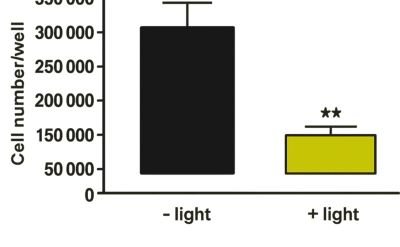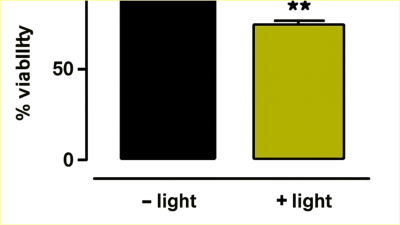Our Research
Results
Bone Density
Barts Hospital
Barts is internationally recognised as one of the world’s leading
institutions in oncology research.
Cancer Experiment
The aim of this experiment is to investigate the effects of Suzie
(spontaneous illuminator) on Human endothelial cell growth for the
treatment of Cancer.
Scientist: Prof Amrita Ahluwalia, Clinical Pharmacology, William Harvey Research Institute, Barts & The London Medical School.
Aim
:
To
investigate
the
effects
of
the
Suzie
on
human
endothelial
cells.
Endothelial
cells
are
the
cells
that
form
a
single
cell
layer
lining
the
luminal
side
of
all
blood
vessels.
These
cells
play
an
essential
role
in
maintaining
the
healthy
state
of
the
blood
vessel
by
ensuring
adequate
provision
to
vital
organs
of
nutrients
and
oxygen
and
by
releasing
substances
that
maintain
the
patency
of
blood
vessels
and
prevent
blockages
(as
those
that
precipitate
heart
attacks).
In
addition,
these
are
the
cells
involved
in
the
formation
of
new
blood
vessels
(angiogenesis).
Method
:
We
plated
human
endothelial
cells
into
6-well
culture
plates
and
counted
the
cells
to
monitor
proliferation.
Endothelial
cells
will
proliferate
over
time
such
that
seeding
of
a
small
number
of
cells
onto
a
culture
plate
over
approximately
4
days
will
proliferate
to
cover
the
culture
plate
area.
The
rate
of
growth
can
be
monitored
by
counting
the
number
of
cells
at
set
times
after
‘seeding’
which
is
how
we
estimated growth rates in this study.
We
conducted
two
types
of
experiment.
In
the
first
series
of
experiments
the
cells
received
continuous
Suzie
exposure
for
the
first
48
hours of growth.
This experiment was halted due to the fact that all cell growth was prevented by the Suzie device
.
In
t
he
second
experiments
the
cells
were
allowed
to
reach
an
active
growth
phase
(72
hours,
see
figure
1
for
normal
growth
pattern)
and
were
then
subjected
to
12
hours
of
exposure
to
the
Suzie.
Plates
were
left
to
grow
in
a
temperature
(37
o
C),
humidity
and
5%
CO
2
in
atmospheric
O
2
environment
in
an
incubator
as
control.
In
a
separate
incubator
cells
were
subjected
to
the
Suzie
which
was
placed
on
top
of the plate. At the end of this time period cells were collected and counted. Cell viability was assessed by trypan blue staining.
Results:
Normal growth of cultured endothelial cells is shown in Figure 1.
Figure 1: Typical cell growth cycle of human endothelial cells
Continuous
exposure
to
the
Suzie
from
time
zero
inhibited
cell
growth
completely
at
48
hours
compared
with
controls, table 1. In light of this the experiment was modified.
Table 1: Cell growth following continuous exposure to the Suzie. Values are mean ± SEM
A further experiment was designed to allow time for the cells to reach an active growth period.
At 72 hours growth the cells received 12 hours of exposure to the Suzie. The growth of the cells was markedly reduced when compared
with control (70000 ± 17320 N=4 vs. 285000 ± 53770 N=4 respectively, p=0.0089), Figure 2. Further investigation also showed the device
to decrease cell viability, i.e. to increase cell death when compared with control (73.00% ± 2.00% N=4 vs. 93.50% ± 3.12% N=4
respectively, p = 0.0015), Figure 3.
Figure 2: Number of cells with and without Suzie light exposure.
Figure 3: Cell viability of cells with and without Suzie light exposure.
The
Scientist
conclusions:
These
experiments
demonstrate
a
profound
inhibitory
effect
of
the
device
on
endothelial
cell
growth.
These
findings
would
suggest
that
the
device
would
be
effective
in
inhibiting
new
vessel
growth.
The
potential
therapeutic
utility
of
such
an
effect
would
likely
fall
in
the
area
of
cancer,
where
new
vessel
growth
perpetuates
tumour
growth
and
survival.
Inhibition
of
new
vessel
growth
would
theoretically
deprive
the tumour of blood flow and thereby inhibit further growth.



Boiler Chicken Trial
Sensational
Results
Sue’s story is extraordinary, but she isn’t alone. Barbara and Robyn have also experienced significant improvements in bone density and overall well-being with the SUZIE device. These real-world stories are not coincidences. They are proof that light frequencies, delivered daily through SUZIE, can transform health from the inside out. Imagine a life without the pain of brittle bones. Imagine feeling energized, balanced, and confident in your wellness, all backed by an improving HRV score that shows your body is recovering, adapting, and thriving. SUZIE isn’t just a wearable. It’s a revolution in long- term wellness.Other Species Trials
Sugar Content (°Brix)
In untreated fruit, sugar content steadily increased as ripening progressed. In SUZIE-treated fruit, this rise was delayed, suggesting a slower ripening process.Firmness (Hardness)
Control fruit softened quickly, while SUZIE-treated fruit maintained firmness for a longer period.Acidity Levels
Acidity dropped significantly in control fruit, indicating ripening. In contrast, treated fruit retained acidity longer.Kiwifruit Trial
A Private Trial
In a private field trial conducted on a commercial chicken farm in Christchurch, New Zealand, we tested the effects of SUZIE on a shed of 10,000 broiler chickens. A second shed of 10,000 chickens served as the control group. Setup: SUZIE units were suspended from the ceiling and evenly spaced in a 10-meter radius pattern to ensure full shed coverage. Both sheds received chicks at the same time and were maintained under identical farming conditions—except for the presence of Suzie. Key Observations Over the 6-Week Lifespan: • Calmer Behavior: From day one, chicks in the SUZIE shed showed reduced stress. Unlike the control group, they did not scatter when humans entered the space. • Bone Strength: At the three-week mark, post-mortem testing of deceased birds revealed significantly stronger bones. SUZIE birds’ legs snapped cleanly, while control birds’ bones bent like rubber before breaking. • Better Feed Efficiency: Birds under SUZIE consumed less feed but gained the same amount of weight as the control group—suggesting improved nutrient absorption and metabolic efficiency.In the trial:
Key Findings on charts below. The trial had to be stopped early, not because of failure, but because the SUZIE-treated fruit hadn't ripened in the expected timeframe. Researchers of ran out fruit to test, as they didn’t anticipate such a substantial delay in ripening. Additional Observation: In our follow-up trial, once the SUZIE-treated Kiwifruit did ripen, the results were quite spectacular with 80% of the fruit having higher sugar content than untreated fruit, suggesting enhanced flavour as well as extended shelf life.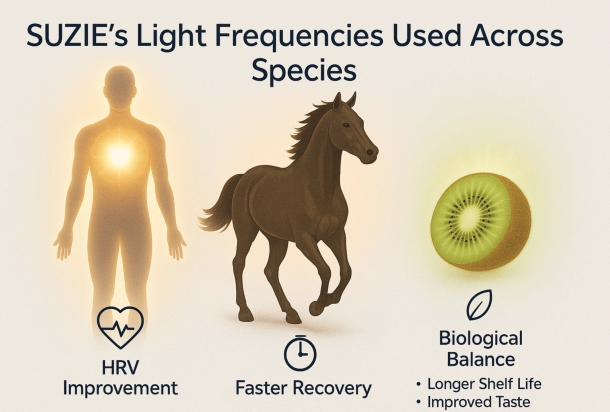
How SUZIE Works
Light-Frequency Wellness for Produce 1. Delays Senescence: Slows cellular aging and ripening 2. Reduces Oxidation: Helps maintain firmness and color 3. Limits Microbial Activity: Extends freshness window 4. Preserves Flavor Compounds: Supports sugar/acid balance and aroma retention Why It Matters Fruit doesn’t lie. SUZIE’s effects are biological, not belief-based. Unlike supplements or sprays, SUZIE uses light energy to activate internal cellular processes—just as it does in humans and animals.

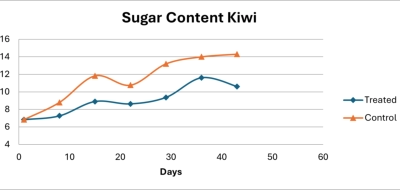
0 hours
48750
48750
24 hours
24707 ± 2143 N=2
21200 ± 1346 N=2
48 hours
62409 ± 847 N=2
15593 ± 1934 N=2
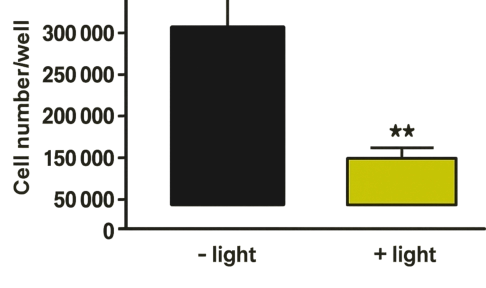


Our
Research
Results
Bone Density
Barts
Hospital
Barts is internationally recognised as
one of the world’s leading institutions
in oncology research.
Cancer Experiment
The aim of this experiment is to
investigate the effects of Suzie
(spontaneous illuminator) on
Human endothelial cell growth
for the treatment of Cancer.
Scientist:
Prof
Amrita
Ahluwalia,
Clinical
Pharmacology,
William
Harvey
Research
Institute,
Barts & The London Medical School.
Aim
:
To
investigate
the
effects
of
the
Suzie
on
human
endothelial
cells.
Endothelial
cells
are
the
cells
that
form
a
single
cell
layer
lining
the
luminal
side
of
all
blood
vessels.
These
cells
play
an
essential
role
in
maintaining
the
healthy
state
of
the
blood
vessel
by
ensuring
adequate
provision
to
vital
organs
of
nutrients
and
oxygen
and
by
releasing
substances
that
maintain
the
patency
of
blood
vessels
and
prevent
blockages
(as
those
that
precipitate
heart
attacks).
In
addition,
these
are
the
cells
involved
in
the
formation
of
new
blood
vessels (angiogenesis).
Method
:
We
plated
human
endothelial
cells
into
6-well
culture
plates
and
counted
the
cells
to
monitor
proliferation.
Endothelial
cells
will
proliferate
over
time
such
that
seeding
of
a
small
number
of
cells
onto
a
culture
plate
over
approximately
4
days
will
proliferate
to
cover
the
culture
plate
area.
The
rate
of
growth
can
be
monitored
by
counting
the
number
of
cells
at
set
times
after
‘seeding’
which
is
how
we
estimated
growth
rates
in this study.
We
conducted
two
types
of
experiment.
In
the
first
series
of
experiments
the
cells
received
continuous
Suzie
exposure
for
the
first
48
hours
of
growth.
This
experiment
was
halted
due
to
the
fact
that
all
cell
growth
was
prevented
by
the
Suzie
device
.
In
the
second
series
of
experiments
the
cells
were
allowed
to
reach
an
active
growth
phase
(72
hours,
see
figure
1
for
normal
growth
pattern)
and
were
then
subjected
to
12
hours
of
exposure
to
the
Suzie.
Plates
were
left
to
grow
in
a
temperature
(37
o
C),
humidity
and
5%
CO
2
in
atmospheric
O
2
environment
in
an
incubator
as
control.
In
a
separate
incubator
cells
were
subjected
to
the
Suzie
which
was
placed
on
top
of
the
plate.
At
the
end
of
this
time
period
cells
were
collected
and
counted.
Cell
viability was assessed by trypan blue staining.
Results:
Normal
growth
of
cultured
endothelial
cells
is
shown
in
Figure 1.
Figure 1: Typical cell growth cycle of human endothelial
cells
Continuous
exposure
to
the
Suzie
from
time
zero
inhibited
cell
growth
completely
at
48
hours
compared
with
controls,
table
1.
In
light
of
this
the
experiment
was
modified.
Table 1: Cell growth following continuous exposure to
the Suzie. Values are mean ± SEM
A further experiment was designed to allow time for the
cells to reach an active growth period. At 72 hours
growth the cells received 12 hours of exposure to the
Suzie. The growth of the cells was markedly reduced
when compared with control (70000 ± 17320 N=4 vs.
285000 ± 53770 N=4 respectively, p=0.0089), Figure 2.
Further investigation also showed the device to
decrease cell viability, i.e. to increase cell death when
compared with control (73.00% ± 2.00% N=4 vs.
93.50% ± 3.12% N=4 respectively, p = 0.0015), Figure
3.
Figure 2: Number of cells with and without Suzie light
exposure.
Figure 3: Cell viability of cells with and without Suzie
light exposure.
Conclusions:
These
experiments
demonstrate
a
profound
inhibitory
effect
of
the
device
on
endothelial
cell
growth.
These
findings
would
suggest
that
the
device
would
be
effective
in
inhibiting
new
vessel
growth.
The
potential
therapeutic
utility
of
such
an
effect
would
likely
fall
in
the
area
of
cancer,
where
new
vessel
growth
perpetuates
tumour
growth
and
survival.
Inhibition
of
new
vessel
growth
would
theoretically
deprive
the
tumour
of
blood
flow and thereby inhibit further growth.



Boiler Chicken Trial
Sensational
Results
Sue’s story is extraordinary, but she isn’t alone. Barbara and Robyn have also experienced significant improvements in bone density and overall well-being with the SUZIE device. These real-world stories are not coincidences. They are proof that light frequencies, delivered daily through SUZIE, can transform health from the inside out. Imagine a life without the pain of brittle bones. Imagine feeling energized, balanced, and confident in your wellness, all backed by an improving HRV score that shows your body is recovering, adapting, and thriving. SUZIE isn’t just a wearable. It’s a revolution in long-term wellness.Other Species
Trials
Sugar Content (°Brix)
In untreated fruit, sugar content steadily increased as ripening progressed. In SUZIE-treated fruit, this rise was delayed, suggesting a slower ripening process.Firmness (Hardness)
Control fruit softened quickly, while SUZIE-treated fruit maintained firmness for a longer period.Acidity Levels
Acidity dropped significantly in control fruit, indicating ripening. In contrast, treated fruit retained acidity longer.Kiwifruit Trial
A Private Trial
In a private field trial conducted on a commercial chicken farm in Christchurch, New Zealand, we tested the effects of SUZIE on a shed of 10,000 broiler chickens. A second shed of 10,000 chickens served as the control group. Setup: SUZIE units were suspended from the ceiling and evenly spaced in a 10-meter radius pattern to ensure full shed coverage. Both sheds received chicks at the same time and were maintained under identical farming conditions—except for the presence of Suzie. Key Observations Over the 6-Week Lifespan: • Calmer Behavior: From day one, chicks in the SUZIE shed showed reduced stress. Unlike the control group, they did not scatter when humans entered the space. • Bone Strength: At the three-week mark, post- mortem testing of deceased birds revealed significantly stronger bones. SUZIE birds’ legs snapped cleanly, while control birds’ bones bent like rubber before breaking. • Better Feed Efficiency: Birds under SUZIE consumed less feed but gained the same amount of weight as the control group—suggesting improved nutrient absorption and metabolic efficiency.In the trial:
Key Findings on charts below. The trial had to be stopped early, not because of failure, but because the SUZIE-treated fruit hadn't ripened in the expected timeframe. Researchers of ran out fruit to test, as they didn’t anticipate such a substantial delay in ripening. Additional Observation: In our follow-up trial, once the SUZIE-treated Kiwifruit did ripen, the results were quite spectacular with 80% of the fruit having higher sugar content than untreated fruit, suggesting enhanced flavour as well as extended shelf life.
How SUZIE
Works
Light-Frequency Wellness for Produce 1. Delays Senescence: Slows cellular aging and ripening 2. Reduces Oxidation: Helps maintain firmness and color 3. Limits Microbial Activity: Extends freshness window 4. Preserves Flavor Compounds: Supports sugar/acid balance and aroma retention Why It Matters Fruit doesn’t lie. SUZIE’s effects are biological, not belief-based. Unlike supplements or sprays, SUZIE uses light energy to activate internal cellular processes—just as it does in humans and animals.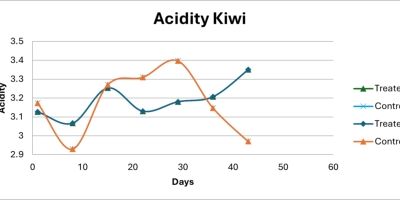
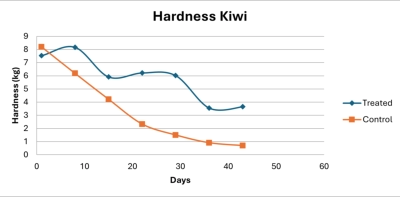
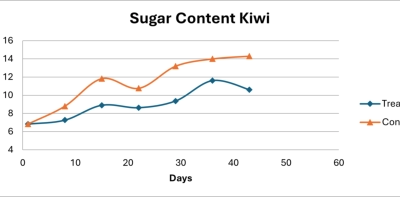
0 hours
48750
48750
24 hours
24707 ± 2143 N=2
21200 ± 1346 N=2
48 hours
62409 ± 847 N=2
15593 ± 1934 N=2
